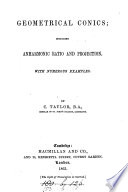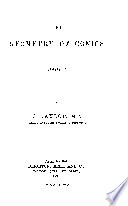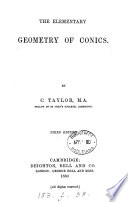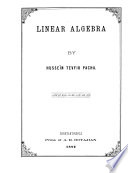 | Charles Taylor - Conic sections - 1863 - 262 pages
...always equal to the ratio SP : PR. Hence a conic might have been defined as the curve traced out by a point which moves in such a way that its distance from the focus bears always the same ratio to its distance from the directrix, measured parallel to any... | |
 | Charles Taylor - Conic sections - 1872 - 121 pages
...respects. CHAPTER I. CHORD-PROPERTIES OF THE PARABOLA. DEF. A parabola is the curve described in a plane by a point which moves in such a way that its distance from a certain fixed point, called the fiocus, is always equal to its perpendicular distance from a certain... | |
 | Philip Kelland - 1873 - 248 pages
...straight lines which do not meet ; find the locus of its centre. CHAPTER VI. THE ELLIPSE. 43. !• IF we define a conic section as "the locus of a point which moves so that its distance from a fixed point bears a constant ratio to its distance from a fixed straight... | |
 | Robert William Griffin - Conic sections - 1879 - 206 pages
...Props, xxix. and xxiv.) CHAPTER II. THE ELLIPSE. DEFINITIONS. AN Ellipse is the curve traced out by a point, which moves in such a way that its distance from a fixed point is to its perpendicular distance from a fixed right line in a constant ratio « : 1 (E being less than... | |
 | Charles Taylor - Conic sections - 1880 - 152 pages
...chapters, as occasion arises.] 1. A CONIC SECTION*, or briefly a Conic, is the curve traced in a plane by a point which moves in such a way that its distance from a given point is in a constant ratio to its distance from a given straight line. The given point is called... | |
 | John Henry Robson - 1880 - 116 pages
...line. Let this cut the line in E. Repeat this process as often as is required. Def.—An ellipse is the locus of a point which moves in such a way that the sum of its distances from two fixed points is constant. This accurate mathematical definition merely... | |
 | Hussein Tevfik (Pacha.) - Algebras, Linear - 1882 - 98 pages
...equation of a sphere. The equation of a Conic Section deduced directly from its definition. 85. We will define a Conic Section as the locus of a point which moves so that its distance from a fixed point bears a constant ratio to its distance from a fixed straight... | |
 | Great Britain. Board of Education - Education - 1912 - 1044 pages
...millimetres. 4. If ABC is a triangle, and D the middle point of BC, show that AB + AC* = 2 (AD* + BD*). Find the locus of a point which moves in such a way that the sum of thesquares of its distances from two given points 4 in. apart is 26 sq. in. 5. Take four... | |
 | Great Britain. Board of Education - Mathematics - 1912 - 632 pages
...millimetres. 4. If ABC is a triangle, and D the middle point of BC, show that AB + AC = 2 (AD' + BD% ' Find the locus of a point which moves in such a way that the sum of the squares of its distances from two given points 4 in. apart is 26 sq. in. 5. Take four... | |
 | Henry Bayard Phillips - Geometry, Analytic - 1915 - 218 pages
...point P is taken on this line such that PQ = AQ. Find the locus of P as OQ turns about O. 3. A point P moves in such a way that its distance from a fixed point O multiplied by its distance from a fixed straight line LK is constant. Find the locus of P. 4. A segment... | |
| |